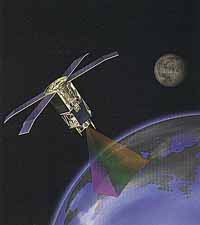Study helps satellites measure Great Lakes’ water quality

NASA’s Seastar Satellite
Ohio State University engineers are helping satellites form a clearer picture of water quality in the Great Lakes.
The study — the first ever to rate the effectiveness of various computer models for monitoring the Great Lakes — might also aid studies of global climate change.
As algae flourishes in the five freshwater lakes every summer, satellite images show the water changing color from blue to green, explained Carolyn Merry, professor of civil and environmental engineering and geodetic science.
When algae levels are too high, water takes on a foul taste and odor that isn’t easily removed by traditional treatment methods. Some forms of algae, such as one called microcystis, are toxic when consumed in large quantities. Though it can be filtered out of drinking water, microcystis can kill fish and birds, and coastal communities often have to ban swimming and water skiing in the summer when the algae blooms.
Computer models enable scientists to measure the color of light reflected from the water to gauge how much algae is present in a lake, and where. The problem: all the available models of this type were originally designed for sea water, not lake water.
“They’ve got it down pat for the ocean,” Merry said of the various models developed by NASA and other agencies over the years. “But lakes are shallower and have different water conditions that affect the wavelengths of light collected by the satellites, so we can get erroneous measurements.”
Merry and master’s degree student Raghavendra Mupparthy reported the results of an initial study of Lake Erie May 25 in Denver at the meeting of the American Society for Photogrammetry & Remote Sensing. They determined which four of the top ocean models may perform well for studies of the Great Lakes.
Most scientists look for evidence of climate change in the oceans rather than in lakes, but that may change in the future, the engineers said.
“Lakes are important because they respond much faster to climate change than oceans do,” Mupparthy said.
Erie is the warmest of the Great Lakes, the shallowest and richest in life, and has changed much in recent years. For instance, the lake has experienced a microcystis outbreak every summer since 1995. The warmer the temperature, the bigger the outbreak, Merry said.
Though lakeside towns routinely measure algae levels firsthand, satellite images give scientists a broader view of trends in the lakes.
“If we want to really understand whats happening in Lake Erie, we can take these computer models and marry them to other data to get a more complete picture,” Merry said.
The models could also apply to other large lakes and seas, such as the Mediterranean.
The key to proving the models valid, she said, is to compare them to actual measurements of algae in the water. Thats what she and Mupparthy did for Lake Erie, by collecting water samples from four sites in October 2000.
They compared the actual algae levels to the levels suggested by 17 different models, each using images of the lake taken by NASA’s SeaStar spacecraft.
Model performance varied widely; one demonstrated an error of more than 250 percent, while several were off by less than one percent.
What set the top-performing models apart was how well they enabled the engineers to remove the interference of atmospheric molecules. Over the ocean, carbon dioxide, ozone, and humidity are fairly constant, but amounts of these molecules fluctuate dramatically over lakes depending on the weather and human activity.
The National Oceanic and Atmospheric Administrations Cooperative Institute for Limnology and Ecosystems Research funded this study. Merry and Mupparthy have applied for funding to collect water samples from more sites, with the hope of customizing a model for Lake Erie.
Contact: Carolyn Merry, (614) 292-6889; Merry.1@osu.edu
Raghavendra Mupparthy, (614) 688-4753; Mupparthy.1@osu.edu
Media Contact
More Information:
http://researchnews.osu.edu/archive/lakeview.htmAll latest news from the category: Earth Sciences
Earth Sciences (also referred to as Geosciences), which deals with basic issues surrounding our planet, plays a vital role in the area of energy and raw materials supply.
Earth Sciences comprises subjects such as geology, geography, geological informatics, paleontology, mineralogy, petrography, crystallography, geophysics, geodesy, glaciology, cartography, photogrammetry, meteorology and seismology, early-warning systems, earthquake research and polar research.
Newest articles

Parallel Paths: Understanding Malaria Resistance in Chimpanzees and Humans
The closest relatives of humans adapt genetically to habitats and infections Survival of the Fittest: Genetic Adaptations Uncovered in Chimpanzees Görlitz, 10.01.2025. Chimpanzees have genetic adaptations that help them survive…

You are What You Eat—Stanford Study Links Fiber to Anti-Cancer Gene Modulation
The Fiber Gap: A Growing Concern in American Diets Fiber is well known to be an important part of a healthy diet, yet less than 10% of Americans eat the minimum recommended…

Trust Your Gut—RNA-Protein Discovery for Better Immunity
HIRI researchers uncover control mechanisms of polysaccharide utilization in Bacteroides thetaiotaomicron. Researchers at the Helmholtz Institute for RNA-based Infection Research (HIRI) and the Julius-Maximilians-Universität (JMU) in Würzburg have identified a…



